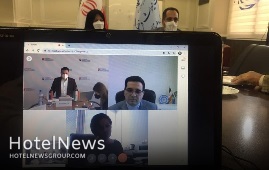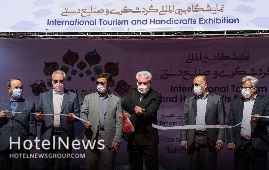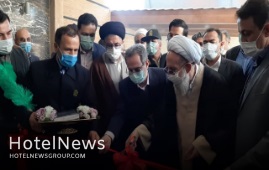
Various collections of the Iranian postage stamps issued since the Qajar era (1789–1925) onwards have been put on show at a newly-established museum in the historical city of Tabriz, the capital of East Azarbaijan province. Setting up inside the 200-year-old mansion (locally named “Khaneh Mojtahediha”), the museum was officially inaugurated on Saturday during a ceremony attended by Ramezanali Sobhanifar, the managing director of the National Post Company, and several local officials, IRNA reported. Furthermore, the museum turns the spotlight on the progress of communication and information technology tools in the country, showcasing numerous items from horse-drawn carts, scales, post boxes, as well as antique telephones and radios. Iran is one of the world’s pioneers in rendering postal services which dates from about 2,500 years ago. The modern post was launched more than one-hundred and fifty years ago by Amir Kabir, who was chief minister to Naser al-Din Shah Qajar. The historical city of Tabriz became the capital of the Mongol Il-Khan Mahmud Gazan (1295–1304) and his successor. Timur (Tamerlane), a Turkic conqueror, took it in 1392. Some decades later the Kara Koyunlu Turkmen made it their capital, it was when the famous Blue Mosque was built in Tabriz. The city retained its administrative status under the Safavid dynasty until 1548 when Shah Tahmasp I relocated his capital westward to Qazvin. During the next two centuries, Tabriz changed hands several times between Persia and Ottoman Empire. During World War I, the city was temporarily occupied by Turkish and then Soviet troops.
Create: May 24, 2021 Edit: May 24, 2021 Regional News
Iranian tourism minister Ali-Asghar Mounesan and Yerevan’s ambassador to Tehran Artashes Toumanian on Monday discussed ways to deepen ties in the realms of tourism and cultural heritage. The officials exchanged views on how to boost travel when the coronavirus is controlled with help of vaccines. “We are ready to increase the tourism ties between the two countries. It seems, within the next few months, the tourism sector would resume as [COVID-19] vaccination is underway worldwide,” Mounesan said. The Iranian minister attached great importance to tourism as a tool, which can foster peace and friendship between various nations. “We pay special attention to tourism with our neighbors because we believe tourism, in addition to economic matters, helps to promote friendship between the nations. Such relationship with Armenia has been improved after the [implementation of] a visa waiver [program].” The envoy, for his part, said many Armenians are not being introduced to Iran’s attractions. “The people of Armenia do not know much about Iran's tourist attractions, if [enough] information is provided and tourism officials and tour operators of the two countries work in this regard, they would be interested in traveling to Iran.” Joint work on the restoration of historical sites and monuments was another issue discussed in the Tehran meeting. “The arena of Iranian cultural heritage is important to us because it dates back to thousands of years ago,” Toumanian said. “We have good experience in the field of intangible cultural heritage and there are many similarities between the two countries in this regard. Armenian specialists can also help to restore the engravings of Iranian churches,” the ambassador explained. Talking about the coexistence of religions in Iran, Mounesan said: “In different cities of Iran, including Yazd, there are places of worship for Muslims, Jews, and Christians, which makes a nation proud. We have even managed to register several churches on the World Heritage list.” Armenian churches To the untrained eye, Iran’s earliest churches may seem modest structures to some but they bear testimony to a vast panorama of architectural and decorative scenes associated with Armenian culture blended with other regional cultures: Byzantine, Orthodox, Assyrian, Persian, and Muslim. St. Thaddeus, St. Stepanos, and the Chapel of Dzordzor are three photogenic ancient churches that constitute the Armenian Monastic Ensembles of Iran, which were collectively inscribed on the UNESCO World Heritage in 2008. They are dotted in fresh and green lands of northwest Iran and are important pilgrimage sites for Armenian-Iranians and others from across the globe. Also known as the Qareh Klise (“the Black Church”), St. Thaddeus, as one of the oldest surviving Christian monuments in the country, is situated in Chaldoran county some 20 kilometers from Maku, adjacent to the borders of Armenia, Azerbaijan, and Turkey. The Chapel of Dzordzor stands tall on the outskirts of Maku. The name narratively originates from a famous painter Hovans Yerz, known as Dzordzortzi, who supervised the chapel’s restoration for a while. The ancient Church shows off elaborate bas-reliefs of flowers, animals, and human figures on its façade and exterior walls. It bears verses of Old and New Testament in Armenian calligraphy as well.
Create: May 13, 2021 Edit: May 13, 2021 Regional News
West Asia’s longest glass suspension bridge with a length of 450 meters is being constructed in the village of Negel, west province of Kordestan, the provincial tourism chief has said. The suspension bridge is a part of a bigger tourist complex including a zip line, eagle zip line, bungee jumping, and rafting, which is unique in the country, Yaqub Guylian announced on Tuesday. The complex also includes a restaurant, pergola, amusement park, and eight accommodation units, the official added. A budget of 500 billion rials (about $12 million at the official exchange rate of 42,000 rials) has been allocated to the project, which aims at attracting more domestic and foreign tourists to the region, he explained. A suspension bridge made of curved sheets of glass, which is the first of its kind in the world, was inaugurated in Ardebil province, northwest Iran in January 2020. However, inaugurated in 2015, and with 345 meters long, 3 meters wide, and 80 meters high, the Meshginshahr suspension bridge is said to be the largest of its kind in West Asia. Last Year Ardebil’s tourism officials announced that the world’s longest suspension bridge with a length of 500 meters is being constructed in the province and is expected to come on stream in June 2021. The name Kordestan refers to the region’s principal inhabitants. After the Turkish invasion of Iran in the 11th century CE (Seljuq period), the name Kurdistan was applied to the region comprising the northwestern Zagros Mountains. It was during the reign of Abbas I the Great of Iran’s Safavid dynasty (1501–1736) that the Kurds rose to prominence, having been enlisted by Abbas I to help stem the attacks of the marauding Uzbeks from the east in the early 17th century.
Create: Apr 28, 2021 Edit: Apr 28, 2021 Regional News
Iranian hotels and other accommodation units remain open as the fourth coronavirus wave gains momentum across the country. To curb the outbreak, President Hassan Rouhani on April 8 announced plans to close down all non-essential businesses, including bazaars and malls in cities color-coded 'red' or very high-risk for a ten-day period as of Saturday. “Hotels and other accommodation unite will be remaining open during the fourth coronavirus wave,” according to the Iranian Hoteliers Association, ISNA reported. The total number of coronavirus cases surged past the two million on Thursday as the new wave of infections has overwhelmed hospitals in all major cities. “We are expecting even more hospitalizations caused by the viral disease over the next few days,” Health Minister Saeed Namaki said on Friday. ICU beds are filled in many cities and the government is to set up makeshift hospitals to make room for more patients and advising patients to visit hospitals only if it is necessary. The number of coronavirus cases rose after millions traveled across the country during the Noruz holiday, which officially began on March 20. The Islamic Republic reported its highest number of daily coronavirus infections in more than three months period after millions challenged government guidelines and traveled during the two-week holiday. Before Noruz, health officials voiced concerns about the fourth COVID wave due to the traditional travels, mostly to visit family and loved ones. Authorities had urged people to limit travel and in-person visits, saying that travels during the Noruz festival could lead to another wave of infections across the country. President Hassan Rouhani declared new travel bans for cities situated in the “red” and “orange” zones to combat the new COVID-19 variant. Rouhani called on people to avoid traveling during the Iranian New Year holidays to help contain the spread of coronavirus. He said it would be forbidden to make trips to cities marked as “red” and “orange” in terms of the prevalence of COVID-19. “We request people to avoid traveling during Noruz holidays for the sake of their own health… It will be forbidden to travel to red and orange towns and cities,” he said. “No one should make any plans to travel to these cities,” he stressed. The Ministry of Health has classified districts based on the rate of coronavirus infections with red color indicating high risk, orange meaning medium, while yellow implied low risk and blue being the least.
Create: Apr 11, 2021 Edit: Apr 11, 2021 Regional News
Iran and Slovakia on Thursday held an online meeting, in which high-level tourism officials, tour operators, and hoteliers discussed ways to boost tourism ties between the two countries in the post-coronavirus era. A key priority for Iran’s tourism sector is to restore tourism ties with previous markets and expand into new international markets such as Slovakia when the coronavirus crisis comes to an end, Mohammad Qasemi, the director for marketing and advertising at the tourism ministry said, IRNA reported. Regarding the unique characteristics and features of Iranian tourism as a different destination for the visitors from Slovakia, he emphasized the need for enhanced private sector relationships between the two countries to lead to the development of an efficient bilateral tourism exchange. Emphasizing the two countries’ capacity for caving, hydrotherapy, skiing, and national and natural parks, he also suggested that successful experiences be shared through training workshops and courses between the two sides. Elsewhere in his remarks, the Iranian official reminded the tremendous impact of the novel coronavirus pandemic on global tourism, adding that the Iranian government has provided support for travel businesses affected by the disease. The Slovak delegation also hailed the expansion of ties in the arenas of tourism and cultural heritage. Moreover, the Slovak Association of Tour Operators & Travel Agents (SACKA) expressed readiness to start bilateral tourism as soon as the virus is contained. The two centuries also agreed to draft a memorandum of understanding to lay the ground for further cooperation including fam tours for media personnel and tour operators. Last November, the World Tourism Organization announced that international tourist arrivals to Iran plunged 72% during the first eight months of 2020 when compared to 2019, highlighting the severe impact of COVID-19 as the main factor. Cultural Heritage, Tourism, and Handicrafts Minister Ali-Asghar Mounesan in October warned that Iran’s cultural heritage and tourism will be in a critical situation if the crises caused by the outbreak of the coronavirus continue. Last August, Mounesan said that Iran’s tourism has suffered a loss of 12 trillion rials (some $2.85 billion) since the outbreak of the coronavirus pandemic. He also noted that the coronavirus pandemic should not bring traveling to a complete standstill. “Corona is a fact, but can the virus stop tourism? Certainly not. For us, the coronavirus is a new experience in dealing with crises that teaches tourism experts around the world how to deal with such a disaster, and thankfully governments are turning this into an opportunity for better planning.” Optimistic forecasts, however, expect Iran to achieve a tourism boom after coronavirus contained, believing its impact would be temporary and short-lived for a country that ranked the third fastest-growing tourism destination in 2019. The latest available data show eight million tourists visited the Islamic Republic during the first ten months of the past Iranian calendar year (started March 21, 2019). Iran welcomed some 7.8 million foreign nationals a year earlier, achieving a 52.5 percent increase year on year. The ancient land embraces hundreds of historical sites such as bazaars, museums, mosques, bridges, bathhouses, madrasas, mausoleums, churches, towers, and mansions, of which 24 being inscribed on the UNESCO World Heritage list. Under the 2025 Tourism Vision Plan, the country aims to increase the number of tourist arrivals from 4.8 million in 2014 to 20 million in 2025.
Create: Mar 13, 2021 Edit: Mar 13, 2021 Regional News
TB Berlin (Internationale Tourismus-Börse Berlin), which bills itself as the world’s leading travel trade show, has presented a taste of Iran. Due to the pandemic, ITB Berlin was held virtually from March 9-12, featuring some 3,300 exhibitors from 120 countries. The Cultural Heritage, Tourism, and Handicrafts Ministry as well as several private-run businesses promoted the country, hammering home the message of diversity and richness in recreational, cultural, natural, and medical arenas of tourism. “The presence of the Islamic Republic of Iran, particularly its the private sector, in this fair shows the dynamism of the country's tourism industry after a year of closure…., and we declare in this exhibition that we are ready to bring tourism back on track again after the epidemic is curbed,” said Vali Teymouri, the deputy tourism chief. The number of foreign visitors to Iran plunged 94% in the first nine months of the current Iranian calendar year (started March 20, 2020), from a year earlier, government data showed on Wednesday, as the coronavirus pandemic takes a heavy toll on the tourism industry. “Some 450,000 foreign travelers arrived in Iran for mainly medical or trade purposes during the first nine months of the year… tightened measures to tackle the new coronavirus has reduced international travel to the country by 94 percent,” according to the official. The global tourism industry has been plagued by the outbreak of the coronavirus for more than a year, which is a record in the history of this industry, the official noted. In an interview with the Tehran Times, the official noted: “We need to revise marketing strategies, and to redefine tourism products by paying great attention to nature tours, rural tourism, and ecotourism, agricultural tourism as a tool to empower local communities and travel businesses.” Tourism minister, Ali-Asghar Mounesan, announced in February that the tourism industry of the country had suffered a loss of some 220 trillion rials (about $5.2 billion at the official exchange rate of 42,000 rials per dollar) since the outbreak of the coronavirus pandemic. “Iran’s tourism has suffered some 220 trillion rials due to corona pandemic so far…. and we hope that with the production of domestic vaccines, tourism will flourish in 1400 [the new Iranian calendar year which begins on March 21],” Mounesan said. “Over 1.5 million jobs have been lost in the tourism sector of Iran due to the COVID-19 disease…. Many of the tourism-insiders are now unemployed or they are staying at home,” Mounesan said. Iranian tourism officials are optimistic about the fate of national tourism as soon as the virus wanes.
Create: Mar 13, 2021 Edit: Mar 13, 2021 Regional News
Iran will set aside ten billion rials (some $240,000 at the official exchange rate of 42,000 rials per dollar) for the restoration of the Great Wall of Gorgan, Cultural Heritage, Tourism and Handicrafts Minister Ali-Asghar Mounesan said on Sunday. Situated in the city of Gorgan, the capital of northern Golestan province, the defensive wall is about 200 km in length, and it was built to prevent the invasion of the northern tribes. It is said to be the longest architectural work of ancient Iran, which was built in 90 years. “We will allocate one billion tomans (ten billion rials) of credit for the restoration of the Great Wall of Gorgan, so that with this credit, the measures for the restoration of this wall, along with aerial imaging and mapping, will be carried out as preliminaries for [the possible] UNESCO registration,” Mounesan said. The minister made the remarks in a meeting with provincial officials and cultural figures during his visit to the lush green province. Last December, Mounesan’s deputy for cultural heritage, Mohammad-Hassan Talebian, said: “Gaining a UNESCO tag for the Great Wall of Gorgan -- one of the longest brick barriers of the ancient world -- is not hard as it is comparable to the Great Wall of China in terms of age, function, and size.” Although there are some issues and obstacles, further efforts to preserve and restore the millennia-old wall could be an acceptable justification for UNESCO to add this structure to the World Heritage list, Talebian explained. To get to that point, complete and accurate mapping of the remnants of the wall is needed, for which a budget of 20 billion rials ($476,000 at the official rate of 42,000 rials) has been allocated so far official added. He also noted that if the mapping project comes to an end by the end of the current Iranian year 1399 (March 20, 2021), the inscription of the wall on the World Heritage list would be discussed and possibly approved by the end of the next summer. Also known as Red Wall, which in some ancient texts is referred to as the Red Snake, this wall is the longest brick ancient barrier between Central Europe and China, longer than Hadrian’s Wall and the Antonine Wall put together and the third-largest wall in the world after the walls of China and Germany. Most parts of the gigantic monument are still hidden underneath the surface through some segments that have so far been unearthed and even restored to former glory. Archaeological excavations have so far identified ditches, brick kilns, earthen dams, water canals, 38 forts, and watchtowers attached to the wall, and more than 25 castles in the southern margin of the wall as well as several ancient sites from prehistoric, historic, and Islamic eras. The gigantic barrier is also more than three times the length of the longest late Roman defensive wall built from scratch, the Anastasian Wall west of Constantinople. The combined area of the forts on the Gorgan Wall exceeds that of those on Hadrian’s Wall about threefold. According to UNESCO, the Gorgan Wall is remarkable not only in terms of its physical scale but even more so in terms of its technical sophistication. To enable construction works, canals had to be dug along the course of the defensive barrier to provide the water needed for brick production. These canals received their water from supplier canals, which bridged the Gorgan River via qanats. One of these, the Sadd-e Garkaz, survives to 700 m in length and 20 m in height but was originally almost one kilometer long. The Gorgan Wall and its associated ancient military monuments provide a unique testimony to the engineering skills and military organization of the Sassanian Empire. They help to explain its geographic extent, from Mesopotamia to the west of the Indian Subcontinent, and how effective border defense contributed to the Empire’s prosperity in the interior and its longevity. These monuments are, in terms of their scale, historical importance, and sophistication, of global significance. Golestan is reportedly embracing some 2,500 historical and natural sites, with UNESCO-registered Gonbad-e Qabus – a one-millennium-old brick tower – amongst its most famous.
Create: Mar 9, 2021 Edit: Mar 9, 2021 Regional News
Tehran’s international tourism and handicrafts fair opened to the public on Tuesday in defiance of a government campaign to improve the hugely-battered travel sector in the face of the novel coronavirus. Cultural Heritage, Tourism, and Handicrafts Minister Ali-Asghar Mounesan and his deputies for tourism, and handicrafts were amongst attendees to the opening ceremony of the fair, which is underway at Tehran Permanent International Fairgrounds. Activists, including tour operators, hoteliers, transport businesses, and tour guides, are hopeful that such days would be numbered at the COVID-19 vaccine is getting more widespread. Since it first surfaced late in 2019, the pandemic has created a greater demand for experiences away from crowds, which is opposite to many traveling pillars. Experts say that such preference for solo travel would probably continue till a coronavirus vaccine is ever-present. “Safe and Responsible Travels” has been picked as the motto of the four-day event that according to organizers could help boost synergy among the two sectors as people have a chance to visit them maybe in a day-long visit! The event is being held according to health protocols announced by the National Headquarters for Coronavirus Control, and following the necessary coordination with the relevant agencies in this field, according to Vali Teymouri, the deputy minister for tourism. Travel agencies, airlines, sea or rail companies, entrepreneurs, startups, banks, insurance brokers, agents or hospitals in charge of health, medical tourism, sports clubs, pilgrimage & eco-tourism companies, representatives of hotels, guesthouses, touristic villages, and free zones are amongst exhibitors in the tourism sector. Furthermore, tens of booths and stands in various exhibition halls have been dedicated to craftspeople, artisans, live performers, and tribespeople who are coming together from every corner of the ancient land to promote skills inherited from generation to generation. Though its main goal of the sales exhibit is to make money and sails of the handicrafts, souvenirs, foodstuff, and various other regional products, it can be a venue for dialogue between exhibitors and visitors and even visiting officials, according to organizers. The fair showcase arrays of personal ornamentation, woodwork, illuminated manuscript, miniature, textile printing, enamel, leatherwork, handwoven textile, calligraphy, traditional musical instrument, metalwork, and marquetry among tens of others while nomadic culinary arts, live workshops, and performances that would gather own fans every corner. Iran expects to reap a bonanza from its numerous tourist spots such as bazaars, museums, mosques, bridges, bathhouses, madrasas, mausoleums, churches, towers, and mansions, of which 24 being inscribed on the UNESCO World Heritage list. Under the 2025 Tourism Vision Plan, it aims to increase the number of tourist arrivals from 4.8 million in 2014 to 20 million in 2025. So it will undeniably try its best to achieve a relatively ambitious goal but when that happens the travel industry is likely to look more altered.
Create: Feb 24, 2021 Edit: Feb 24, 2021 Regional News
Iranian tourism minister Ali-Asghar Mounesan and his deputy for handicrafts, Pouya Mahmoudian, honored some exemplary crafters and artisans on Saturday. Behruz Zarindashti in ceramic and Sara Hedayat in costume designing received Silver Cypress, during the closing ceremony of the 5th Fajr national handicrafts festival, one of Iran’s major crafts shows held in the National Museum of Iran. Furthermore, Zeinab Masudi in illumination, Abbas Jalalikia in woodwork, Saru Moqerchian in metalwork, and Vajiheh Sadat Jalali in woodcarving received honorable mentions, according to organizers. Two the recently-deceased veteran crafters; Ahmad Shishegar, who was a master of tilework, and Amir Saeim, a master of toreutics, were honored posthumously during the ceremony, which was attended by tens of artists, crafters, and cultural officials as well. Over 150 crafters practicing different fields of handicrafts participated in this edition of the festival, of which several were honored during the ceremony. This edition of the festival, which brings together works from all over the country and is a venue for showcasing tens of ancient and modern Iranian handicrafts, was held entirely online due to the coronavirus outbreak. The event showcased woodwork, illuminated manuscript, miniature, textile printing, enamel, leatherwork, calligraphy, metalwork, mirrorwork, and marquetry, among others. It also featured potteries, ceramics, personal ornamentation, rugs, and kilim carpets. With 14 entries, Iran ranks first globally for the number of cities and villages registered by the World Crafts Council, as China with seven entries, Chile with four, and India with three ones come next. In January 2020, the cities of Shiraz, Malayer, and Zanjan and the village of Qassemabad were designated by the WCC- Asia Pacific Region, putting Iran’s number of world crafts cities and villages from ten to 14. Shiraz was named a “world city of [diverse] handicrafts”. Malayer was made a global hub for woodcarving and carved-wood furniture. Zanjan gained the title of a “world city of filigree”. And Qassemabad village, which is nationally known for its traditional costumes, was also promoted to a world hub of handicrafts. Chador Shab, a kind of homemade outer-garment for women, was, however, the main subject for the WCC assessment for the village. Iran exported $523 million worth of handicrafts during the calendar year 1398 (ended March 19, 2020). Of the figure, some $273 million worth of handicrafts were exported officially through customs, and about $250 million was earned via suitcase trade (allowed for customs-free and tax-free transfer) through various provinces, according to data provided by the Ministry of Cultural Heritage, Tourism and Handicrafts. Ceramics, pottery vessels, handwoven cloths as well as personal ornamentations with precious and semi-precious gemstones are traditionally exported to Iraq, Afghanistan, Germany, the U.S., the UK, and other countries.
Create: Feb 22, 2021 Edit: Feb 22, 2021 Regional News
Two acclaimed African American developers – Victor MacFarlane of MacFarlane Partners and R. Donahue Peebles of The Peebles Corporation – are doubling-down on their multi-million-dollar effort to bring thousands of new jobs and economic benefits to the nation’s second-largest city as development partners of Angels Landing, their $2 billion twin-tower luxury hotel project in downtown L.A.’s Bunker Hill neighborhood. MacFarlane and Peebles are majority-owner principals of Angels Landing Partners, LLC, the development partnership responsible for conceiving, designing, building, and operating Angels Landing. The partnership was officially selected by L.A. City officials at the conclusion of the city’s competitive bid process in 2017. Their partnership’s intentions are firmly focused on completing construction of Angels Landing before elite athletes, sports officials and tourists worldwide converge in L.A. for the 2028 Olympic Summer Games. Victor B. MacFarlane, chairman and CEO, MacFarlane Partners said, “Angels Landing aligns well with many of the projects we have built in the past 30 years throughout the U.S., including two residential developments recently completed near Pershing Square.” “The foundation of our business has always been to strengthen communities where we do business,” Mr. MacFarlane said. “We believe we can help communities prosper. We know Angels Landing will have a significant positive impact on L.A.’s economy. The ripple effect of Angels Landing’s substantial economic and employment activity will reverberate throughout L.A. County by providing good-paying union jobs to construct our hotel project and extensive career opportunities when the project is completed, and its hotels are open to the public. We have spent more than $10 million to move our project forward. We’re not letting the coronavirus pandemic slow us down. We anticipate our project entitlement this year,” he added. Angels Landing is comprised of two towers, each anchored by its own five-star hotel. In addition to the hotels, the development will feature an expansive modern urban park – known as Angels Landing Plaza – designed to serve as a pedestrian-centered, transit-adjacent, open space environment in the heart of downtown L.A. R. Donahue Peebles, Chairman and CEO, The Peebles Corporation said, “Equity and inclusion are bedrock principles at the Peebles Corporation. My success is predicated on opportunities I received because of those two important tenets. I have built an impressive collection of commercial and residential projects in New York, Washington, D.C., Miami, and other U.S. cities.” “In each city, I’ve been most excited about using my influence to empower Black-owned, Latino-owned, and women-owned business leaders. My company works diligently to help minority-owned enterprises grow their businesses through procurement contracts established through our development projects,” Mr. Peebles said. According to an analysis prepared by BJH Advisors, LLC., more than 8,300 new jobs will be created during Angels Landing’s project design and construction. The New York City-based firm’s report estimates Angels Landing would additionally create more than 800 permanent jobs in downtown L.A. An estimated 500 jobs would be created by vendors in the L.A. County region providing good and services to the two luxury hotels. In addition to new job creation, the BJH Advisors analysis projects Angels Landing would give L.A.’s local economy a $1.6 billion boost and contribute $731 million to local worker’s earnings during its construction. The project would generate as estimated 12 million in recurring tax revenues and $2.4 million annually in local property tax revenues, according to the report. “With Angels Landing, the transformative impact of empowerment and economic inclusion will be felt by an array of businesses, including Latino- and Asian-owned businesses. We have committed to a goal of 30% M/WBE contracting across the board for our project. We’re raising the bar for economic inclusion for development projects in Los Angeles,” Mr. Peebles added. Angels Landing Plaza will frame the angular, multi-level Bunker Hill site as a publicly accessible, privately managed park amenity, establishing it as a vibrant, inviting, and treasured locale for L.A.’s downtown neighborhood residents, weekday commuters, nightlife seekers, tourists, and hotel guests. L.A.’s historic Angel’s Flight funicular will operate on its hillside-climbing route contiguous to the Angels Landing development. “With our commitment to Angels Landing, we are committing to the future of downtown Los Angeles. Despite the millions of dollars expended so far to keep our project on-track, and notwithstanding the strong pandemic-induced recessionary pressures on L.A.’s economy, we continue to push hard to make our plans for Angels Landing a reality. Having recently completed our Park Fifth apartment complex, a two-building development adjacent to Pershing Square, Angels Landing represents our continued faith in the economic future of downtown Los Angeles,” Mr. MacFarlane said. Mr. Peebles said, “2020 was a trying year for nearly every sector in the business world. And the first three quarters of 2021 may be equally challenging. But we’ve faced big challenges in the past and always managed to prevail. The success of our development businesses is a testament to our drive and commitment to build projects that improve the quality of life in the communities where they’re built.” Mr. MacFarlane said, “The economic impact of the coronavirus pandemic has been significant this year. Some of those negative economic impacts, such as lagging job growth, are projected to extend well into 2021. But pessimistic economic indicators and projections have not shaken our resolve to build Angels Landing. We’re making our investment to create new jobs for L.A. area residents. We’re confident Angels Landing will help the L.A. economy rebound and gain strength. Angels Landing will create thousands of jobs that will result in millions of dollars circulating throughout the L.A. region providing a needed boost to small businesses.”
Create: Feb 11, 2021 Edit: Feb 11, 2021 International News
Officials of Shaner Hotels, an award winning, international hotel owner, operator and developer, today announced the grand opening of the 145-room SpringHill Suites by Marriott Columbus Dublin located in Bridge Park. Shaner will operate the hotel in a partnership with ownership, Crawford Hoying, a large-scale real estate developer headquartered in Central Ohio. The Springhill Suites by Marriott Columbus Dublin provides the freshest hotel choice in Dublin’s Bridge Park, a new development giving an urban feel to this upscale suburb,” said Plato Ghinos, president, Shaner Hotels. “The hotel provides an all-suite option that includes complimentary breakfast – providing a reliable, refreshing and unexpected choice in the Dublin market. Our staff will focus on sales, service and style to bring the best in customer service to our guests.” Situated in the heart of downtown Dublin at 4475 Bridge Park Avenue, SpringHill Suites is conveniently located near local attractions such as the Columbus Zoo & Aquarium, the highly anticipated Riverside Crossing Park and only minutes to downtown Columbus. The hotel is surrounded by numerous walkable dining and entertainment options provided by the Bridge Park neighborhood. The hotel also provides multiple amenities for travelers, including a 24/7 fitness center, 840 square feet of meeting space, a complimentary breakfast buffet, a lobby bar, multiple outdoor lounging spaces and suite-style rooms designed to fuse form and function, equipped with separate areas to both work and relax. These stylized guest rooms are furnished with an oversized work area, a phone with voicemail, free Wi-Fi, a mini-refrigerator, a microwave oven, a trundle sofa bed and Smart TV entertainment. “At the rate in which Bridge Park is growing, the demand for another hotel was obvious,” said Brent Crawford, founder and principal, Crawford Hoying. “We couldn’t be more appreciative of our continued partnership with Shaner and the fantastic hospitality provided at each of the hotels within our developments. We’re confident that Springhill Suites will be no exception.” “We continue to seek opportunities in strong primary and secondary markets with new products surrounded by multiple demand generators,” Ghinos noted. “While the pandemic has hit the travel and hospitality industries particularly hard, we believe we see the light at the end of the tunnel with the recent arrival and deployment of the vaccines. Brand new hotels such as this will hold the lead position as travelers begin their return to both business and leisure travel in the weeks and months to come.”
Create: Feb 7, 2021 Edit: Feb 7, 2021 International News
The first-ever hotel in the city of Rey, southeast of Tehran, was inaugurated on Tuesday on the occasion of Ten-Day Dawn (Jan. 31- Feb. 10, marking the victory anniversary of the Islamic Revolution), ISNA reported. The inauguration ceremony was attended by Mohammad Mohammadi Reyshahri, the custodian of the Holy Shrine of Shah Abdol Azim, and Anushiravan Mohseni Bandpey, the governor-general of Tehran province, and several local officials and tourism insiders. A budget of 800 billion rials (about $19 million at the official exchange rate of 42,000 rials per dollar) has been allocated to the project which adds 42 rooms and 108 beds to the hospitality sector of the city, the provincial tourism chief Parham Janfeshan announced on the sidelines of the ceremony. The construction and inauguration of this hotel will lead to the development of religious tourism infrastructure in the city, which will bring more welfare to the pilgrims of the Holy Shrine of Shah Abdol Azim, Janfeshan said. Construction work of the hotel took four years in a piece of land covering more than eight hectares, he added. The history of settlement in Rey dates from the 3rd millennium BC. It is featured in the Avesta (the original document of Zoroastrianism, an Iranian religion) as a sacred place, and it is also mentioned in the book of Tobit, of the biblical Apocrypha, and by classical authors. According to Encyclopedia Britannica, Rey was one of the capital cities of the Parthian empire (3rd century BC–3rd century CE). It was captured by the Muslim Arabs in 641 CE. During the reign of the Muslim caliph al-Mahdi in the 8th century, the city grew in importance until it was rivaled in western Asia only by Damascus and Baghdad. Islamic writers described it as a city of extraordinary beauty, built largely of fired brick and brilliantly ornamented with blue faience (glazed earthenware). It continued to be an important city and was briefly a capital under the rule of the Seljuqs, but in the 12th century, it was weakened by the fierce quarrels of rival religious sects. In 1220 the city was almost entirely destroyed by the Mongols, and its inhabitants were massacred. Most of the survivors of the massacre moved to nearby Tehran, and the deserted remnants of Rey soon fell into complete ruin. Rey, however, retains enough history to give it a different sensibility, its key sight is the elaborately decorated Shah Abdol Azim Shrine. Beside the shrine complex is a lively bazaar, while further afield are a couple of minor historical attractions.
Create: Feb 5, 2021 Edit: Feb 6, 2021 Regional News
